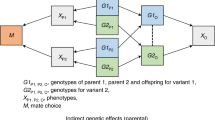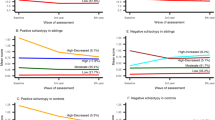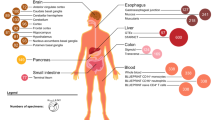Abstract
Crohn's disease (CD) is a complex genetic disorder for which aetiology is unknown. Recently, genetic factors for susceptibility have been described. Several genetic loci have been mapped and partially explain the familial aggregations of the disease. However, environmental factors may also contribute to these aggregations. We considered that if the role of non-genetic factors was negligible, CD patients would be randomly distributed in sibships with multiple affected siblings. On the other hand if there was a significant environmental contribution, the siblings would be affected non-randomly over exposure status. In order to test this hypothesis, we studied 102 sibships with two or more affected siblings. A statistical test, named Cluster of Affected Sibling Test or CAST, was developed, based on the exact calculation of the probability of observing a given number of clusters of affected siblings in multiplex families. The null hypothesis of a random distribution of affected siblings was rejected (P=0,005). The observed excess of affected sibling clusters indicates that birth order influences the disease status. Considering that an adjacent order of birth is a global estimate of environmental sharing, this observation strongly suggests that environmental factors contribute to the observed familial aggregations of the disease. This observation provides evidence that familial CD is a relevant tool for further studies of environmental factors and gene-environment interaction. More generally, the CAST statistics may be widely applicable to estimate the involvement of environmental factors in the aetiology of other binary traits which may be observed in multiple members of the same sibship.
Similar content being viewed by others

Log in or create a free account to read this content
Gain free access to this article, as well as selected content from this journal and more on nature.com
or
References
Shivananda, S, Lennard-Jones, J & Logan, R et al: Incidence of inflammatory bowel disease across Europe : is there a difference between North and South? Results of the European collaborative study on inflammatory bowel disease (EC-IBD). Gut, (1996). 39, 690–697.
Gower-Rousseau, C, Salomez, JL & Dupas, JL et al : Incidence of inflammatory bowel disease in Northern France (1988–1990). Gut, (1994). 35, 1433–1438.
Hugot, JP, Zouali, H, Lesage, S & Thomas, G : Etiology of the inflammatory bowel diseases. Int J Colorectal Dis, (1999). 14, 2–9.
Tysk, C, Lindberg, E, Jarnerot, G & Floderus-Myrhed, B : Ulcerative colitis and Crohn's disease in an unselected population of monozygotic and dizygotic twins. A study of heritability and the influence of smoking. Gut, (1988). 29, 990–996.
Thompson, NP, Driscoll, R, Pounder, RE & Wakefield, AJ : Genetics versus environment in inflammatory bowel disease: results of a British twin study. Br Med J, (1996). 312, 95–96.
Orholm, M, Binder, V, Sorensen, TIA & Kyvik, KO : Inflammatory bowel disease in a Danish register. Gut, (1996). 39, Suppl 3 A187
Cho, JH, Nicolae, DL & Gold, LH et al : Identification of novel susceptibility loci for inflammatory bowel disease on chromosomes 1p, 3q, 4q: evidence for epistasis between 1p and IBD1. Proc Natl Acad Sci USA, (1998). 95, 7502–7507.
Cho, JH, Nicolae, DL & Ramos, R et al : Linkage and linkage disequilibrium in chromosome band 1p36 in American Chaldeans with inflammatory bowel disease. Hum Mol Genet, (2000). 9, 1425–1432.
Duerr, RH, Barmada, MM, Zhang, L, Pfutzer, R & Weeks, DE : High-density genome scan in Crohn disease shows confirmed linkage to chromosome 14q11-12. Am J Hum Genet, (2000). 66, 1857–1862.
Hampe, J, Shaw, SH & Saiz, R et al : Linkage of inflammatory bowel disease to Human chromosome 6p. Am J Hum Genet, (1999). 65, 1647–1655.
Hugot, JP, Laurent-Puig, P & Gower-Rousseau, C et al : Mapping of a susceptibility locus for Crohn's disease on chromosome 16. Nature, (1996). 379, 821–823.
Rioux, JD, Daly, MJ & Silverberg, MS et al : Genetic variation in the 5q31 cytokine gene cluster confers susceptibility to Crohn disease. Nat Genet, (2001). 29, 223–228.
Rioux, JD, Silverberg, MS & Daly, MJ et al : Genomewide search in Canadian families with inflammatory bowel disease reveals two novel susceptibility loci. Am J Hum Genet, (2000). 66, 1863–1870.
Satsangi, J, Parkes, M & Louis, E et al : Two stage genome wide search in inflammatory bowel disease provides evidence for susceptibility loci on chromosome 3, 7 and 12. Nature Genet, (1996). 14, 199–202.
Hugot, JP, Chamaillard, M & Zouali, H et al : Association of NOD2 leucine-rich repeat variants with susceptibility to Crohn's disease. Nature, (2001). 411, 599–603.
Ogura, Y, Bonen, DK & Inohara, N et al : A frameshift mutation in NOD2 associated with susceptibility to Crohn's disease. Nature, (2001). 411, 537–539.
Rose, JDR, Roberts, GM, Williams, G, Mayberry, JF & Rhodes, J : Cardiff Crohn's disease jubilee: the incidence over 50 years. Gut, (1998). 29, 346–351.
Kyle, J : Crohn's disease in the Northeastern and Northern Isles of Scoland: an epidemiological review. Gastroenterology, (1992). 103, 392–399.
Persson, PG, Ahlbom, A & Hellers, G : Inflammatory bowel disease and tobacco smoke—a case control study. Gut, (1990). 31, 1377–1381.
Sutherland, LR, Ramcharan, S, Bryant, H & Fick, G : Effect of cigarette smoking on recurrence of Crohn's disease. Gastroenterology, (1990). 98, 1123–1128.
Lindberg, E, Järnerot, G & Huiltfeld, B : Smoking in Crohn's disease: effect on localisation and clinical course. Gut, (1992). 33, 779–782.
Lennard-Jones, JE : Classification of inflammatory bowel disease. Scand J Gastroenterol, (1989). 24, Suppl 170 2–6.
Gent, AE, Hellier, MD, Grace, RH, Swarbrick, ET & Coggon, D : Inflammatory bowel disease and domestic hygiene in infancy. Lancet, (1994). 343, 766–767.
Acknowledgements
We acknowledge for their contribution to family recruitment doctors Joaquin Balanzo, Vibeke Binder, Bruno Bonaz, Yoram Bouhnik, Guillaume Cadiot, Antoine Cortot, Salvatore Cucchiara, Bart Crusius, Jean-Jacques Delchier, Bernard Duclos, Jean-Louis Dupas, Yigael Finkel, Jean-Paul Galmiche, Jean-Pierre Gendre, Denis Golfain, Corinne Gower-Rousseau, Christer Grännö, Denis Heresbach, André Lachaux, Hervé Lautraite, Catherine Lenaerts, Eric Lerebours, Victor Levy, Robert Löfberg, Helmut Malchow, Philippe Marteau, Robert Modigliani, Alain Morali, Francesco Pallone, Salvatore Pena, André Rotenberg, Isabelle Rousseau, Jacques Schmitz, Fergus Shanahan, Iradj Sobhani, Hans Svensson, André Van Gossum, Myriam Van Winckel and Michel Veyrac. This project received financial support from : the European Community (Contract Biomed 2 n° BMH4-97-2098), the Ministère Français de l'Education Nationale et de la Recherche, the INSERM, the Direction Générale de la santé (convention n° 4T004C), the Association François Aupetit and the Institut de Recherche des Maladies de l'Appareil Digestif and the Swedish Society of Medicine.
Author information
Authors and Affiliations
Consortia
Corresponding author
Appendices
Maple procedure for CAST
>restart:>G=unapply((x-y+1)/binomial(x,y)*X+1-(x-y+1)/binomial(x,y),x,y):
PSI:= G(3,2)^37*G(4,2)^16*G(5,2)^7*G(6,2)^7*G(7,2)^7
*G(8,2)^4*G(9,2)*G(10,2)^2*G(12,2)*G(13,2)^2
*G(4,3)^2*G(5,3)^5*G(6,3)*G(7,3)^2*G(8,3)*G(9,3)
*G(13,3)
*G(5,4)*G(8,4)*G(13,4)
*G(7,5)
*G(11,7):
>evalf(expand(PSI)):
>for i from 0 to degree(PSI) do D.i=evalf(coeff(PSI,X,i)) od:
Dmax=0:
for i from 0 to degree(PSI) do
If D.i>Dmax then index=i:
Dmax=D.i:
Fi
od:
mean:=sum(‘i*D.i’,‘i’=1..degree(PSI));# mean expected number of ‘consecutive’ sibships according to H0
indexmax:=index;# indexmax is the mode of the distribution P(S=k)
Proba:= sum(‘D.i’,‘i’=58..degree(PSI));# value of P(S⩾58)
Results
mean=45.75
indexmax=46
Proba=0.005271
Rights and permissions
About this article
Cite this article
Hugot, JP., Cézard, JP., Colombel, JF. et al. Clustering of Crohn's disease within affected sibships. Eur J Hum Genet 11, 179–184 (2003). https://doi.org/10.1038/sj.ejhg.5200932
Received:
Revised:
Accepted:
Published:
Issue date:
DOI: https://doi.org/10.1038/sj.ejhg.5200932
Keywords
This article is cited by
-
NOD2 exonic variations in Iranian Crohn's disease patients
International Journal of Colorectal Disease (2011)


